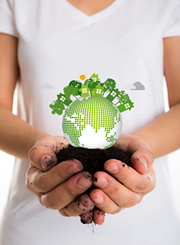How to Teach Kids Environmental Awareness Through Eco-Friendly Beauty Products
Raising children involves not only developing basic skills but also instilling values that will help them become responsible and mindful adults. One such value is caring for the environment. But how can you make this understandable and interesting for a child?
One way is to introduce them to the concept of vegan cosmetics and show how choosing these products can positively impact the world.
Every day, we make countless small decisions that shape our lifestyle. Choosing cosmetics is a perfect example of a simple action that can be used to teach children how their choices affect nature, animals, and our collective future.
What Are Vegan Cosmetics?
Vegan cosmetics are beauty products that contain no animal-derived ingredients and are not tested on animals. This means they exclude common components like beeswax, lanolin, carmine (a natural dye made from insects), and many others. Instead, they rely on plant-based and synthetic alternatives that are safe and effective. A large selection of such cosmetics is available on the website ecobeaut.com
Moreover, many vegan cosmetic brands adhere to eco-friendly principles, such as using biodegradable packaging, reducing carbon emissions, and supporting fair trade practices.
Why Is It Important to Talk About This with Kids?
Today’s children are growing up in a world where environmental issues are becoming increasingly apparent. From climate change to the extinction of animal species, these challenges require a conscious approach to educating the next generation. By telling kids about vegan cosmetics, you not only introduce them to these issues but also show that even small steps, like choosing the right product, can lead to significant change.
For example, you can explain how brands that focus on eco-friendly beauty products contribute to environmental sustainability. This discussion helps kids understand how their everyday choices, like picking the right cosmetics, can positively impact the planet.
How to Explain the Value of Vegan Cosmetics to Kids?
1. Ethics and Animal Protection
Kids love animals, which makes the topic of vegan cosmetics especially relatable to them. Explain that many traditional cosmetic brands test their products on animals, causing them harm. Highlight that buying vegan cosmetics helps protect animals and create a kinder world.
Example: “Imagine instead of using beautiful flowers and plants in cosmetics, some companies take ingredients from animals’ lives. But we can choose products that care for both us and animals!”
2. Lessons in Sustainability
Explain that vegan cosmetics not only help animals but also protect the environment. Many brands minimize waste, use recycled packaging, and adopt eco-friendly production methods.
Joint activity: Suggest that your child look for products at home with “vegan” or “eco-friendly” labels. This can be an engaging and educational activity.
3. Building Conscious Habits
By choosing cosmetics with your children, you show them how to be a responsible consumer. They begin to think about how their actions impact the world and learn to make choices based on values.
Little girl gleefully playing in ocean near a sandy shoreline.
Game idea: “Let’s pretend we’re choosing cosmetics that make nature happy. What do you think those products would be?”
Practical Steps to Introduce Eco-Friendly Habits
To make environmental awareness a part of daily life, it’s important to act gradually. Here are some simple steps:
1. Choose the Right Products
Together with your child, pick cosmetics labeled “Vegan” or “Cruelty-Free.” Explain that these labels guarantee no animal-derived ingredients or animal testing.2. Create an Eco-Friendly Cosmetic Kit
Let your child choose a few products for their own personal kit. This could include natural soap, vegan cream, or a gentle shampoo.3. Talk About Recycling
Show your child how to properly dispose of cosmetic packaging. This can lead to a broader discussion about the importance of recycling.4. DIY Workshops at Home
Host small at-home experiments to make natural cosmetic products—like creating a face scrub from sugar and coconut oil. This fun activity will help your child better understand the value of natural products.
The Impact of These Lessons on the Future
Teaching kids through simple and understandable actions, such as choosing vegan cosmetics, helps them develop a mindful attitude toward the world. These lessons will stay with them for life, influencing their choices and actions.
A child who understands the importance of caring for the environment and animals will grow into a more responsible and compassionate adult. This matters not only for their future but also for the future of our planet.




 Katie Brenneman is a passionate writer specializing in education, mental health, family lifestyle and online safety. When she isn’t writing, you can find her with her nose buried in a book or hiking with her dog, Charlie. You can follow her on
Katie Brenneman is a passionate writer specializing in education, mental health, family lifestyle and online safety. When she isn’t writing, you can find her with her nose buried in a book or hiking with her dog, Charlie. You can follow her on 




